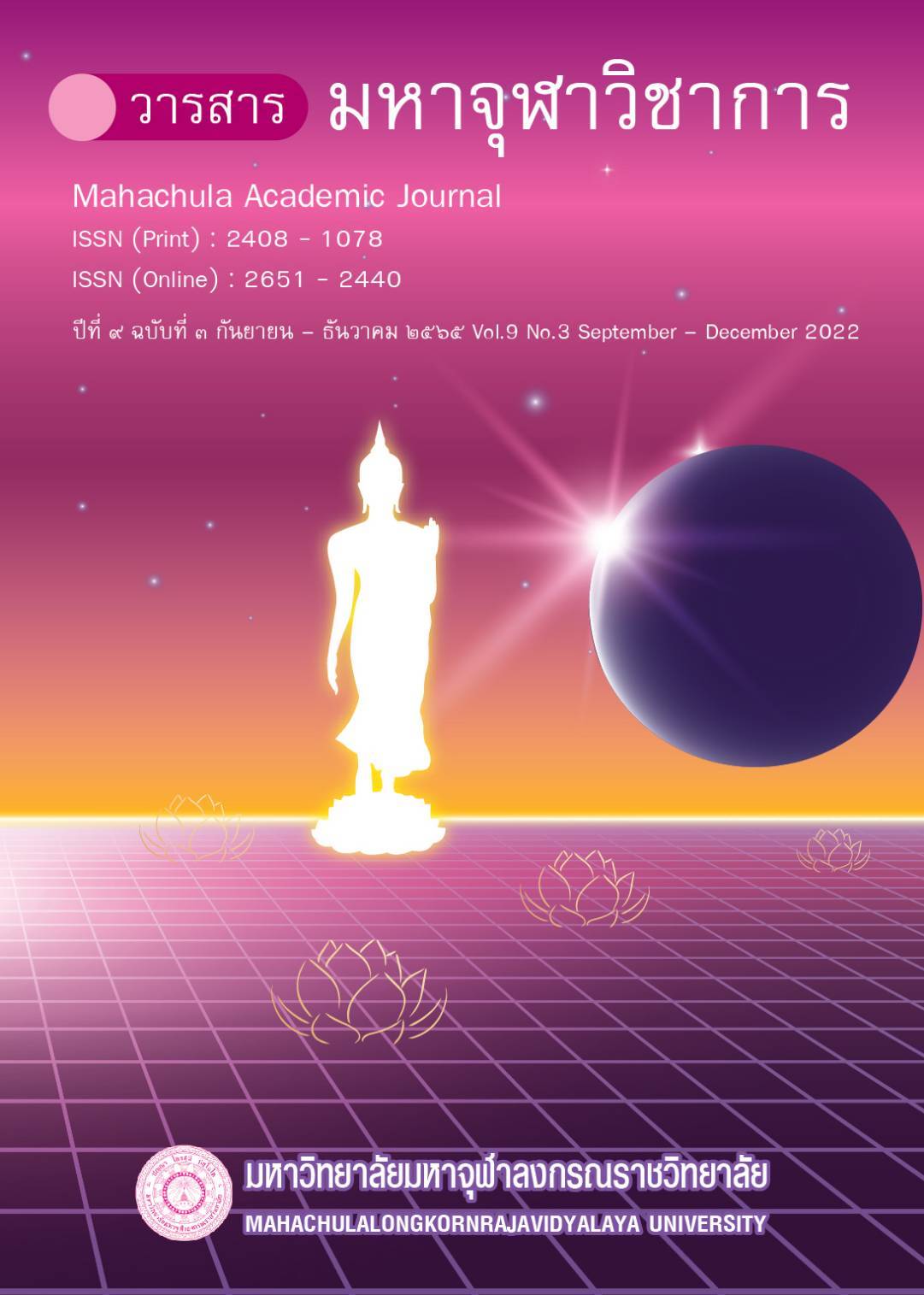Usage of Digital media with Self-Directed Learning in Topic of Five Basic Buddhist Precepts of Moral Practices and Five Dharma for Primary 4 (Grade 4) Students
Main Article Content
Abstract
The purposes of this research were to: (1) develop digital media with self-directed learning on the Five Precepts and Five Dharma for Primary 4 (Grade 4) students Wat Khian Khet school with the efficiencies of 80/80 (2) compare students’ learning achievement before and after using the media, Five Dharma for Primary 4 (Grade 4) students Wat Khian Khet school and (3) evaluate students' Wat Khian Khet school satisfaction towards the digital media with self-directed learning on the Five Precepts and Five Dharma. The samples of this study were 30 students studying in Wat khien khet school in the 2nd semester of academic year 2021 chosen using the lottery method of simple random sampling. The research instruments consisted of the digital media with self-directed learning, media and content quality assessment forms, achievement tests, and students' satisfaction evaluation form. The statistics used to analyze the data were mean, standard deviation, and dependent t-test.
The research results showed that: (1) the digital media with self-directed learning on the Five Precepts and Five Dharma for Primary 4 (Grade 4) students had the efficiency of 90.84/88.40 which was higher than the defined criteria 80/80, (2) the students’ learning achievement after using the media was higher than before using the media at a statistical level of .05, and (3) the students' satisfaction towards the digital media with self-directed learning on the Five Precepts and Five Dharma for Primary 4 (Grade 4) students was at the highest level ( = 4.60, SD = 0.58).
Article Details

This work is licensed under a Creative Commons Attribution-NonCommercial-NoDerivatives 4.0 International License.
References
ดังตฤณ. ผิดที่ไม่รู้. กรุงเทพมหานคร: ฮาวฟาร์, ๒๕๕๑.
บุญธรรม กิจปรีดาบริสุทธิ์. สถิติเพื่อการวิจัย. กรุงเทพมหานคร: จามจุรีโปรดักท์, ๒๕๔๙.
พูลศักดิ์ หอมสมบัติ. “รูปแบบและการเสริมสร้างวัฒนธรรมการดำรงชีวิต ของครอบครัวรักษาศีล ๕ ในภาคตะวันออกเฉียงเหนือ”. วารสารมหาจุฬาตานีปริทรรศน์ มหาวิทยาลัยมหาจุฬาลงกรณราชวิทยาลัย. ปีที่ ๓ ฉบับที่ ๕ (มกราคม-มิถุนายน ๒๕๖๔): ๔-๕.
ลัดดา ปิยะวงศ์รุ่งเรือง. คู่มือปฏิบัติธรรม คั้นออกมาจากศีล. กรุงเทพมหานคร: ฟ้าอภัย, ๒๕๔๕.
ล้วน สายยศ และอังคณา สายยศ. เทคนิคการวิจัยทางการศึกษา. กรุงเทพมหานคร: สุวีริยาสาส์น, ๒๕๓๘.
โครงการประเมินเทคโนโลยีและนโยบายด้านสุขภาพ. HITAP นำเสนอข้อสรุปเชิงนโยบายโครงการคัดกรองพัฒนาชุดสิทธิประโยชน์ด้านการคัดกรองสุขภาพประชากรในประเทศไทย และ โครงการพัฒนานโยบายด้านการสร้างเสริมสุขภาพและป้องกันโรค สำหรับเด็กและเยาวชน ต่อคณะกรรมการสำนักงานหลักประกันสุขภาพแห่งชาติ. [ออนไลน์]. แหล่งที่มา: https://www.hitap.net/news/16636 [๑ กุมภาพันธ์ ๒๕๖๕].
จรินทร อุ่มไกรและ ไกยสิทธิ์ อภิระติง. การพัฒนาสื่อดิจิทัลร่วมกับเทคโนโลยีความจริงเสริม โดยอาศัยการเรียนรู้แบบร่วมมือด้วยเทคนิค STAD ในรายวิชาคอมพิวเตอร์ ชั้นประถมศึกษาปีที่ ๖. [ออนไลน์]. แหล่งที่มา: https://ph02.tci-thaijo.org › article › download [๑ กุมภาพันธ์ ๒๕๖๕].
สุพัชญา เจรีรัตน์. การเปรียบเทียบคุณสมบัติทางจิตมิติและประสิทธิภาพของแบบวัดสถานการณ์การรู้สื่อ ดิจิทัลที่มีรูปแบบต่างกัน. [ออนไลน์]. แหล่งที่มา: https://shorturl.asia/FsYDx [๑ กุมภาพันธ์ ๒๕๖๕].
สุธาสินี นาคกรดและคณะ. การพัฒนาบทเรียนออนไลน์เพื่อส่งเสริมการเรียนรู้ด้วยตนเอง เรื่องสิ่งแวดล้อมทางวัฒนธรรมและสังคม ชั้นประถมศึกษา ปีที่ ๖. [ออนไลน์]. แหล่งที่มา: https://shorturl.asia/m8jVe [๑ กุมภาพันธ์ ๒๕๖๕].
อัจฉรา อมะรักษ์. แนวโน้มในยุคดิจิทัล. [ออนไลน์]. แหล่งที่มา:https://shorturl.asia/3IjW2 [๑ กุมภาพันธ์ ๒๕๖๕].


